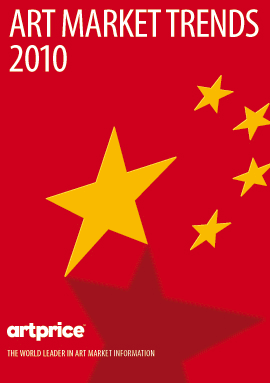The report is already summarized from the Artprice site, and I have included that in the block below. As many readers are aware, I think these reports and analysis can be helpful tools to the appraiser in writing about the state of markets and in supporting any claims for market adjustments. (That is one reason I started the Fine and Decorative Arts Market Confidence Survey, to be used as a tool by appraisers in supporting market trends and market analysis. Please complete the survey if you have not already done so. Click HERE to take the survey.)
Artprice summarizes its Market Trends 2010 report
To download the 24 page Artprice Market Trends 2010 document, click HERE.During the past decade, two strong trends have emerged: firstly, as per the words of Thierry Ehrmann, the Ceo and founder of Artprice, the world leader in art market information, “we have seen a veritable revolution in the geopolitics of the global art market… Over the last 10 years, China jumped from ninth place to first place in 2010, becoming the world’s largest auction marketplace for Fine Art and overtaking the United States and the UK, the grand masters of the market since the 1950s.” France, constantly loosing competitiveness year after year, comes out the big looser of the past decade, as shown by delay in implementing the auction reform required for 28 Dec. 2009 by the European Directive, and by the Drouot scandal, which is an ongoing judicial saga.
The second strong trend in the year 2010 is the unanimous statement by art market players that an unprecedented mutation has affected the commerce of art. The market’s very structure has changed, with the evolution of Internet and its 2 billion and a half users who have triggered the dramatic acceleration of online art sales. The competition generated by the more than 260 art fairs organised each year around the world and the importance of investors and investment funds in the market. The example they set and the media attention they received was sufficiently strong to make investment in art a new socio-cultural phenomenon. The assimilation of art to a financial asset by a minority of investors clearly gave birth to a new model: that of an “art exchange”. China seems to have been a pioneer in this field as the Chinese government launched in 2009 the Shenzen Cultural Assets and Equity Exchange.
The year 2010 was rich in events: after the strong price inflation between 2004 and 2008 and the severe market contraction from October 2008 to the summer of 2009, a rapid recovery followed, taking the market to unprecedented highs. In short… the decade saw a very substantial acceleration of the market and a considerable shift of its polarity towards Asia. After the previous art market meltdown in 1991, it took 4 years of patience before prices began to recover. This time round it took only 18 months.
In 2008, after the collapse of Lehman Brothers, China became the motor of global economic recovery. At the same time, the Chinese government showed the importance it attributes to art and culture at events such as the Olympic Games in 2008, the World Expo in Shanghai in 2010 and with the groundwork performed by the Ministry of Culture and Finance to make museums free in China. The pride of Chinese culture has also been clearly expressed by its valuation on world markets. Chinese collectors are regarded as role models, working for the good of the nation. Indeed, on the back of the sponsorship and investment patronage of these collectors, Chinese artists have closed the price gap on Western artists incredibly quickly.
This year, Artprice’s annual art market report – based on 5.4 million auction results from 3,600 auction houses around the world and distributed to over 6,300 media organisations and international institutions every year in 7 languages – will focus particularly on China’s successful conquest of the global art market. Our 2010 Art Market Trends contain macro- and micro-economic analyses providing the keys to understanding the annual evolution of the global auction market. It discusses the major trends in the market, analysed throughout the year on the ArtMarketInsight page of our website, by the Artprice press agency and by our Econometrics Department. To complement this objective appreciation of the art market based on a year of global auction results, Artprice also offers numerous original rankings such as the Top 500 artists by auction revenue and the Top 100 auction results of the year.
SUMMARY
- Editorial
- Roller coaster
- Post-War and Contemporary Art in the global market
- 2010: Renewed competition
- A mixed return for Contemporary signatures: the “successes” of Hirst, Murakami and Koons
- China: the new global leader
- New York vs Beijing
- Catching up on Old Masters and imposing their Contemporary artists
- France’s place in the art world
- Art Market Confidence Index – 2010, a positive year
- Twitter: 2010 in 140 characters
- Top 10 Artists
- Top 100 auction performances in 2010
- Top 500 artists by auction revenue in 2010


No comments:
Post a Comment